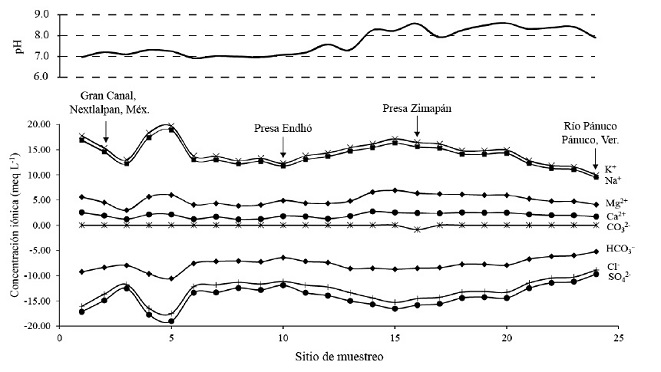Variación de la calidad del agua en el cauce principal de la cuenca del río Pánuco
DOI:
https://doi.org/10.28940/terra.v41i0.1601Palabras clave:
CROSS, salinidad, sodicidad, río Moctezuma, río TulaResumen
El uso de aguas residuales en el riego agrícola contribuye a mejorar la productividad del suelo y a resolver los problemas de escasez del agua. Sin embargo, también se generan problemas de salinidad y sodicidad en el suelo, toxicidad para las plantas, y problemas de salud pública. En la cuenca del río Pánuco, que se origina en el Valle de México y desemboca en el Golfo de México, se encuentra el Valle del Mezquital, donde se riegan más de 90 000 ha con aguas residuales que llegan a través de diversas vías, entre ellas el Gran Canal del Desagüe. Una parte del agua que se utiliza para el riego se infiltra y se incorpora al cauce del río Tula, que desemboca en la presa Zimapán. A partir de la presa Zimapán, el cauce adquiere el nombre de río Moctezuma y en la parte baja de la cuenca río Pánuco hasta la descarga en el Golfo de México. El objetivo de este trabajo fue evaluar la calidad del agua a lo largo del cauce de la cuenca del río Pánuco mediante el muestreo, las determinaciones en laboratorio y el análisis mediante índices de calidad con criterios agronómicos, y comparar los resultados de la parte alta de la cuenca con la parte baja. Los resultados indican que las aguas residuales que se incorporan al Valle del Mezquital impactan a lo largo de todo el cauce, pero en mayor medida en la parte alta de la cuenca. En todos los puntos de muestreo el agua se clasifica como bicarbonatada-sódica, el índice de CSR indica que el 96% de los sitos presenta algún tipo de restricción para el riego, la CE no es idónea en ninguno de los puntos y la relación de adsorción de sodio (RAS) evidencia riesgos de sodicidad.
Descargas
Publication Facts
Reviewer profiles N/D
Author statements
- Academic society
- Terra Latinoamericana

















